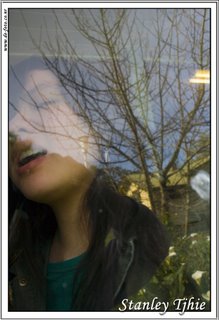Unforgiving

This is Miechelle. Yes, no mistake in that spelling. This was taken at the Camp Coorimungle during the morning's breakfast. I was outside taking photos of the flowers when she started to walk out. Pointed the camera and her and "snap". She was actually giving me those faces and just nice, I had captured a very interesting and valuable moment.
Glass is a uniform amorphous solid material, usually produced when the viscous molten material cools very rapidly to below its glass transition temperature, without sufficient time for a regular crystal lattice to form. The most familiar form of glass is the silica-based material used for windows, containers and decorative objects.
Common glass contains about 70-72 weight % of silicon dioxide (SiO2). The major raw material is sand (or "quartz sand") that contains almost 100% of crystalline silica in the form of quartz. Even though it is an almost pure quartz, it may still contain a small amount (<>Cold work includes traditional stained glass work as well as other methods of shaping glass at room temperature. Glass can also be cut with a diamond saw, or copper wheels embedded with abrasives, and polished to give gleaming facets; the technique used in creating waterford crystal. Art is sometimes etched into glass via the use of acid, caustic, or abrasive substances. Traditionally this was done after the glass was blown or cast. In the 1920s a new mould-etch process was invented, in which art was etched directly into the mould, so that each cast piece emerged from the mould with the image already on the surface of the glass. This reduced manufacturing costs and, combined with a wider use of colored glass, led to cheap glassware in the 1930s, which later became known as Depression glass. As the types of acids used in this process are extremely hazardous, abrasive methods have gained popularity.(courtesy wikipedia.com)
Glass is a uniform amorphous solid material, usually produced when the viscous molten material cools very rapidly to below its glass transition temperature, without sufficient time for a regular crystal lattice to form. The most familiar form of glass is the silica-based material used for windows, containers and decorative objects.
Common glass contains about 70-72 weight % of silicon dioxide (SiO2). The major raw material is sand (or "quartz sand") that contains almost 100% of crystalline silica in the form of quartz. Even though it is an almost pure quartz, it may still contain a small amount (<>Cold work includes traditional stained glass work as well as other methods of shaping glass at room temperature. Glass can also be cut with a diamond saw, or copper wheels embedded with abrasives, and polished to give gleaming facets; the technique used in creating waterford crystal. Art is sometimes etched into glass via the use of acid, caustic, or abrasive substances. Traditionally this was done after the glass was blown or cast. In the 1920s a new mould-etch process was invented, in which art was etched directly into the mould, so that each cast piece emerged from the mould with the image already on the surface of the glass. This reduced manufacturing costs and, combined with a wider use of colored glass, led to cheap glassware in the 1930s, which later became known as Depression glass. As the types of acids used in this process are extremely hazardous, abrasive methods have gained popularity.(courtesy wikipedia.com)




1 comment:
she looks hot and in some kind of pain/pleasure
Post a Comment